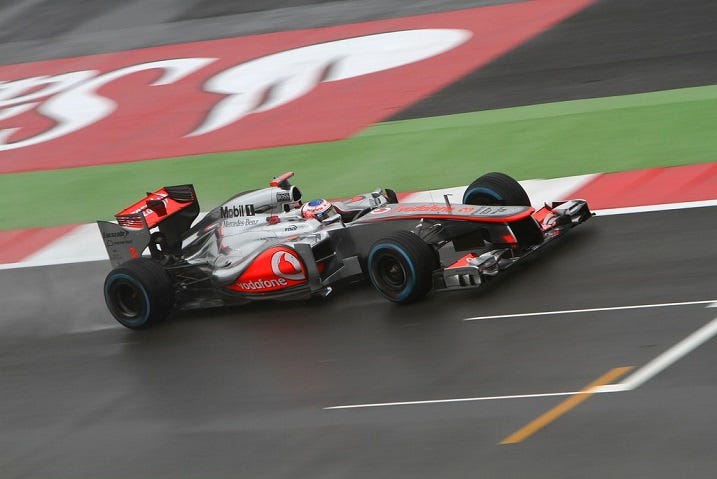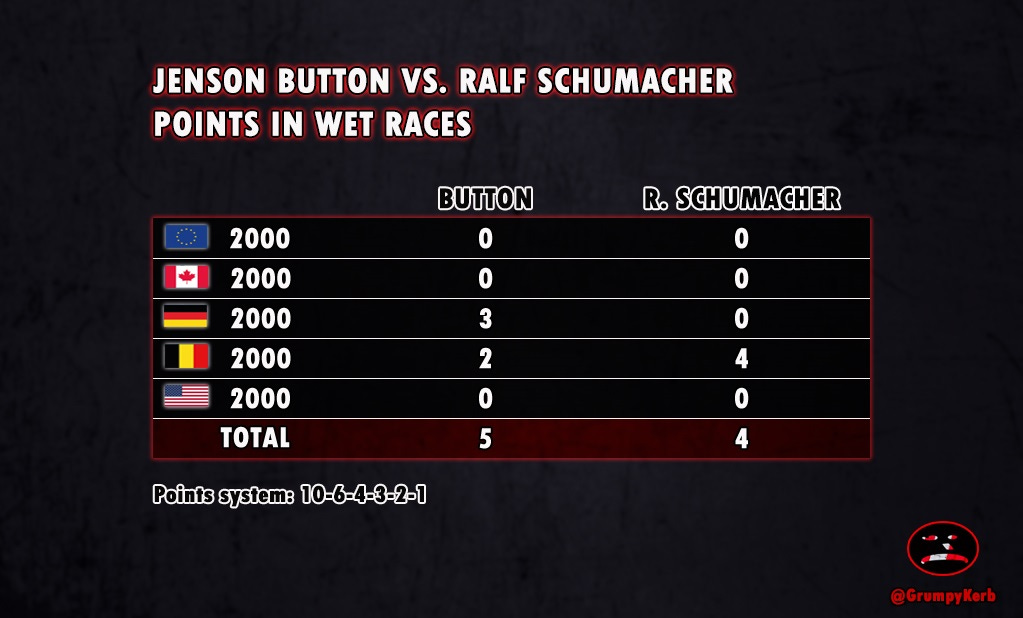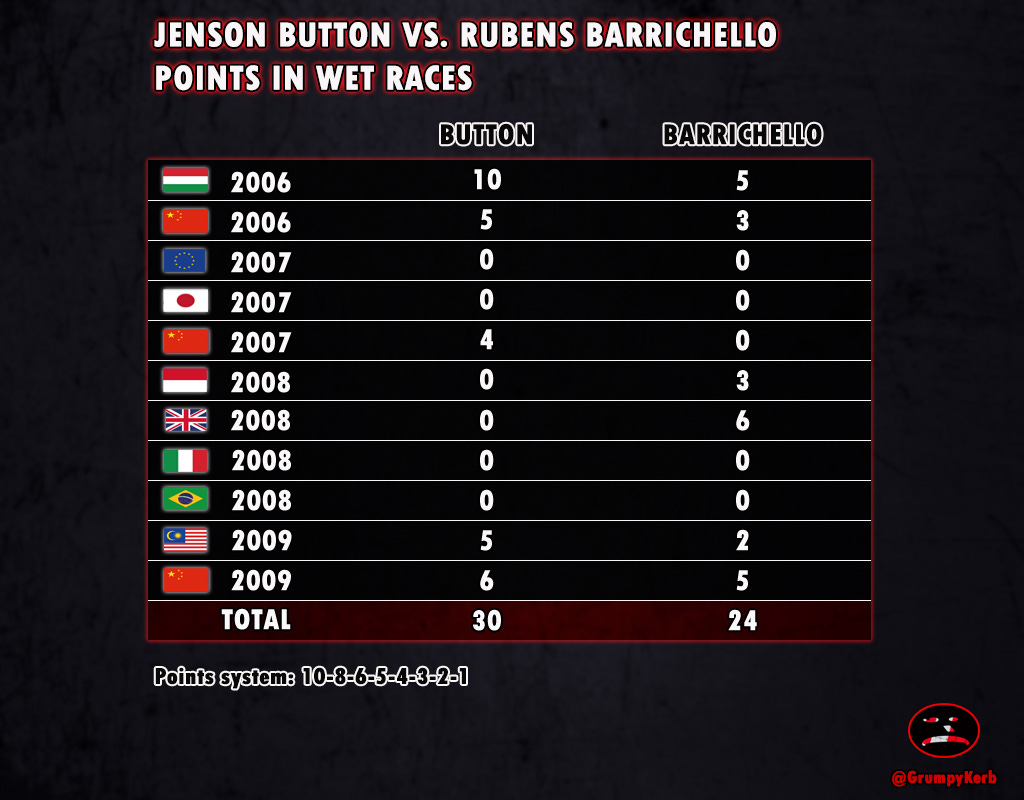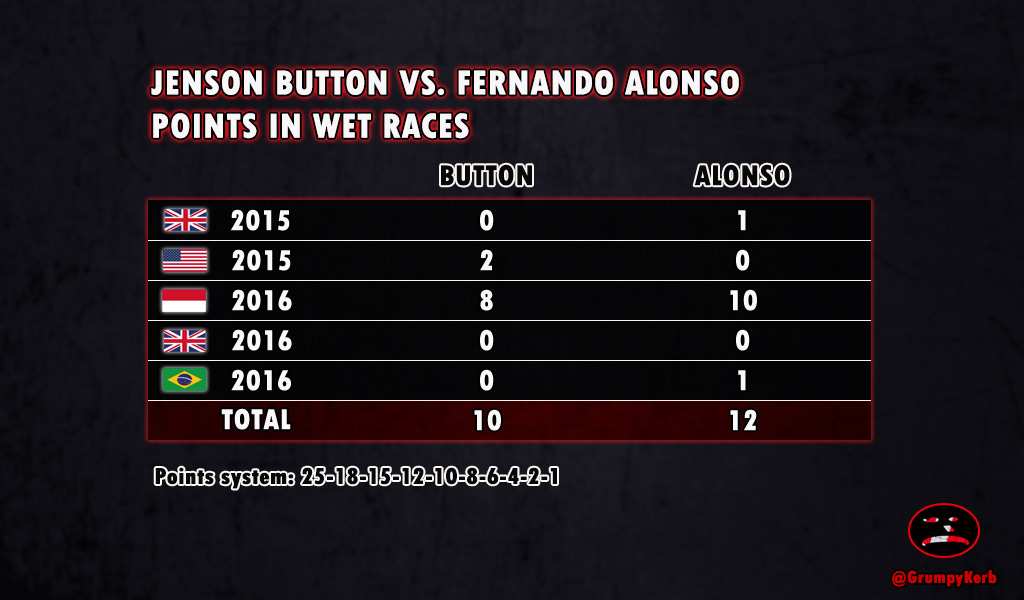Jenson the Mixed Conditions Fortune-Teller Button
How the Brit fared against his teammates in wet races.
Being wrong is a part of that annoying thing called life. Every homo sapiens learns this through experience in almost every field of activity. I can attest. I’m a human being, unfortunately.
Among the many things I was wrong about in a field of Formula 1, there is one person that stands out. One person I clearly misjudged and underrated: Jenson Button. I always thought about him as nothing more than a midfield driver. My mind didn’t change a bit even when he won the championship in 2009. I thought he was lucky.
It was only during Button’s stint at McLaren in the early 2010s, when in my eyes, he emerged from the midfield driver cocoon and transformed into a top driver.
One of the main reasons why my opinion shifted was Button’s prowess in mixed conditions. No one was better at assessing the conditions and choosing the right tire at the right time. It was like practiced hydromancy. He could read moisture.
Button collected some impressive wins during that period. Australia and China in 2010 and of course, the 2011 Canadian Grand Prix, which is probably a top choice when discussing the best races of the 2010s.
Truth to be told, he excelled in mixed conditions from the start. I just didn’t pay attention, and the Brit didn’t always have a car to showcase his forte. There is a cliché about rain being the great equalizer; well, that’s true only to a certain extent. However, that’s a discussion for another time.
Regardless of whether a car competes at the front, the back, or somewhere in the middle of the pack, one thing is sure: your teammate is your benchmark. That’s the first person a driver is compared to. The most important criterion is the points scored. They decide the championship order.
That’s the idea behind this post.
What Is a Wet Race?
“A race only qualifies as wet-weather if wet tires were faster than slick tires for at least 10% of the race.” That’s the definition I used. It’s not mine. I borrowed it from this post. I like it because it’s simple and excludes events such as the 2000 Japanese Grand Prix, a race where it only rained only a bit in the closing laps, and wet tires weren’t even needed.
The general idea behind this definition is that a line must be drawn; otherwise, every race affected by rain, even when it has no impact on the competition, would be classified as a wet race.
Here are the results:
Ralf Schumacher
In his rookie season at Williams, Button outscored the more experienced teammate in 5 wet races we had in the 2000 season.
As you can see, both Button and Schumacher didn’t score a lot and often. The primary reasons for this were the points system, which rewarded only the top 6 finishers, as well as issues related to reliability and incidents. The German became a collateral victim in a duel between Jos Verstappen and Eddie Irvine at Nurburgring and a direct victim of a torpedo sent by Jacques Villeneuve in Montreal. The Brit on the other hand was the instigator at Spa, where his overly optimistic maneuver spun the car driven by his future teammate, Jarno Trulli.
Giancarlo Fisichella, Jarno Trulli, Jacques Villeneuve and Takuma Sato
As you can see, both Button and Schumacher didn’t score a lot and often. The primary reasons for this were the points system, which rewarded only the top 6 finishers, as well as issues related to reliability and incidents. The German became a collateral victim in a duel between Jos Verstappen and Eddie Irvine at Nurburgring and a direct victim of a torpedo sent by Jacques Villeneuve in Montreal. The Brit on the other hand was the instigator at Spa, where his overly optimistic maneuver spun the car driven by his future teammate, Jarno Trulli.
I decided to group these gentlemen together because the number of wet races as Button’s teammate didn’t exceed 2 for any of them. There is not much to discuss with such a small sample size. In the 2000 season, we had 5 rain-affected races, and in the following 5 years, we had a total of 6 wet Sundays. Such is the allure of rain in Formula 1.
Button partnered with Fisichella at Benetton in 2001, which had a total number of 2 wet races: Malaysia and Brazil. The Italian scored one point at Interlagos. The Brit had zero to his name.
One year later, the team changed its name to Renault. The French company had acquired Benetton in March, 2000, but it raced for 2 seasons under the old banner.
Fisichella departed, and Trulli joined the team. The only wet race of 2002 took place at Silverstone. Both Button and his teammate failed to score points due to reliability issues. The Brit was classified and officially finished in 12th place, so I guess you can give him the win over his teammate based on a countback.
2002 season was the last to utilize the 10-6-4-3-2-1 points system, which was subsequently replaced by the 10-8-6-5-4-3-2-1.
In 2003, our hero joined BAR Honda. New team, new teammate, this time Jacques Villeneuve. In a chaotic race in Brazil, the Canadian driver earned 3 points, while Button finished aquaplaning and crashing because of the standing water at Curva do Sol. To be fair to him, 3 other drivers DNFed for the same reason: Mark Webber, Juan Pablo Montoya, and Michael Schumacher. The Brit would have outscored his teammate in the wet conditions if his engine hadn’t exploded in the USA, when he was 2nd.
Finally, Takuma Sato and our hero competed in only one wet race as teammates: the 2005 Belgian Grand Prix. It was one of Button’s better performances, as he stood on the podium and received a trophy for 3rd place. The Japanese, or more precisely his visor, received a slap from angry Michael Schumacher, whom Sato-san had bulldozed out of the race at La Source.
Rubens Barrichello
In 2006, BAR became a Honda factory team, and Button got a new teammate. Barrichello was no slouch in the wet. The Brazilian secured his first 2 pole positions in tricky conditions. The first one in a Jordan (Spa 1994), the second in a Stewart (Magny-Cours 1999). His maiden victory was also celebrated under a cloudy, rainy sky (Hockenheim 2000). That time he drove a red Ferrari.
The quality of the cars, that Button and Barrichello drove at Honda and Brawn GP during their final year at Brackley, ranged from backmarkers to contenders. Both drivers experienced their share of ups and downs, ultimately finishing close in points, although Button reached greater heights. He won 2 times, both in unforgettable races: his maiden win at the Hungaroring in 2006 and another at Sepang in 2009. One 3rd place at Silverstone in 2008 was the maximum Barrichello could achieve.
Lewis Hamilton
The 2010 season began in Bahrain, ushering in numerous changes. Refueling was dropped after 16 seasons, and a new points system was introduced. Brawn GP became a Mercedes factory team and both Button and Barrichello left. The Brit changed Brackley for Woking and partnered with Lewis Hamilton. This marked the first pairing of two world champions since Alain Prost and Ayrton Senna in 1989, also at McLaren.
Hamilton already had great wins in tricky conditions under his belt, the most notable being the 2008 British Grand Prix, and he had established a reputation as an excellent wet weather performer.
Win or bust. Two of the zeros in his record can be attributed to incidents: one in Belgium in 2010, where he was taken out by Sebastian Vettel, and another in Silverstone in 2011, when a wheel fell off immediately after he exited the pits. Button was accountable for the other two non-finishes, which occurred due to his underperformance at Yeongam in 2010 and Sepang in 2012.
Hamilton also suffered two DNFs. The first one was a consequence of a collision between him and Button in the famous 2011 Canadian Grand Prix, deemed a racing incident by the stewards. The following year, he was involved in another DNF in Brazil, when Nico Hulkenberg lost control of his car and collided with Hamilton's vehicle while attempting to overtake the McLaren driver.
Button had the edge in wins: 5 vs. 1. Hamilton demonstrated greater consistency between the two, which contributed to the close score.
Sergio Perez and Kevin Magnussen
After Hamilton left for Mercedes, Button became a leader at McLaren, where he finished his career. He had two one-year teammates: Perez (2013) and Magnussen (2014). This period marked a steady decline for the Woking team, and those who played a part in it, Marin Whitmarsh and Sam Michael, departed from McLaren in 2014.
The Malaysian Grand Prix was the only wet race of 2013. Perez scored 2 points, while Button scored a retirement. He had been doing pretty good job in the race, before the team bottled his pit stop. In consequence he ended up a lap behind. He ultimately retired 2 laps before the end of the race due to a mechanical issue.
Kevin Magnussen scored no points in the rain-affected races in Hungary and Japan in 2014. Button scored in both: 1 in Budapest 10 at Suzuka. The latter is, at least in my opinion, his best race in the last 3 years of his career.
Fernando Alonso
2015 and 2016, McLaren hit rock bottom after changing their engine supplier from Mercedes to Honda. Both Button and his new teammate Alonso, who returned to McLaren seven years after the tumultuous 2007 season, had to compete in poor cars.
Alonso was able to outscore Button in wet conditions. He is the only driver who competed in at least 5 rain affected races as Button's teammate to achieve this. However, it was still a close contest.
Respect on His Name
In the period between 2006 and 2013, commonly known as the V8 era, Jenson Button won 7 wet/mixed condition races. More than any other driver. Fernando Alonso and Lewis Hamilton were his closest competitors, each securing victory 4 times.
Maybe he wasn’t the fastest driver in challenging conditions, but he certainly excelled at reading them. He was so adept that the strategies of rival teams often adhered to a simple principle: do what Button does. Can you think of a better compliment?
And he has a rather impressive record against formidable teammates in wet races. Don't you think?









